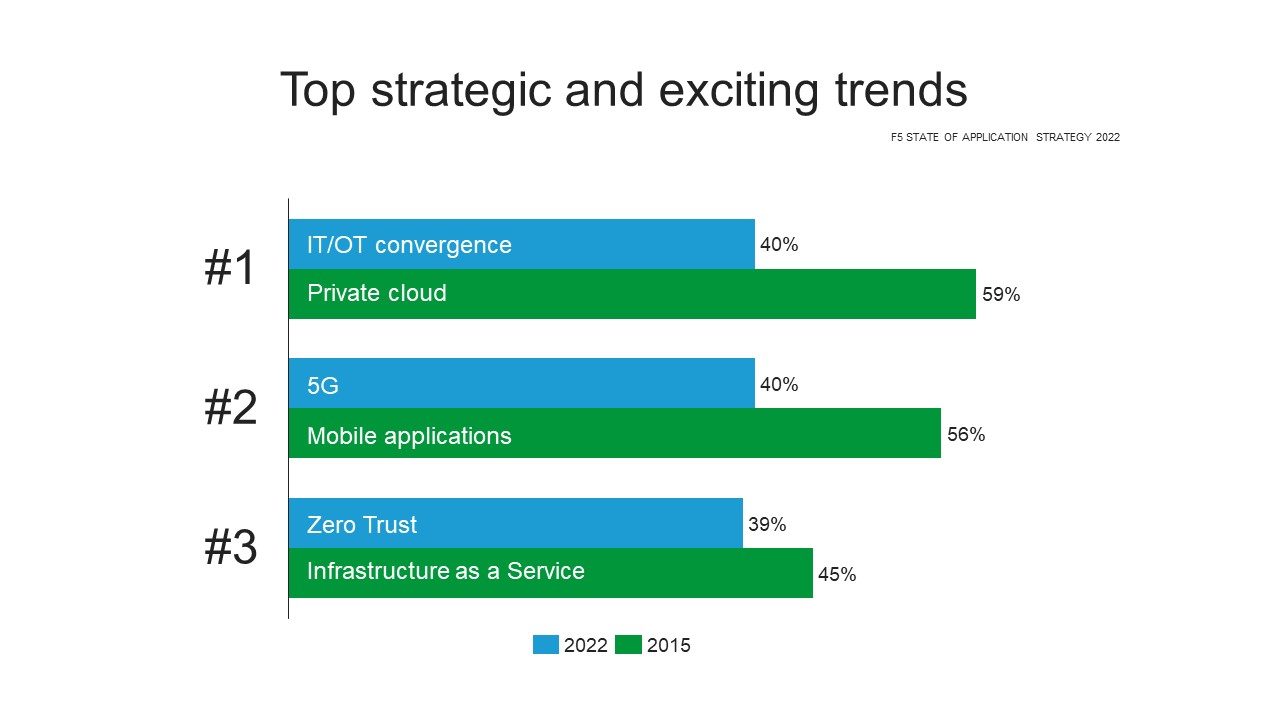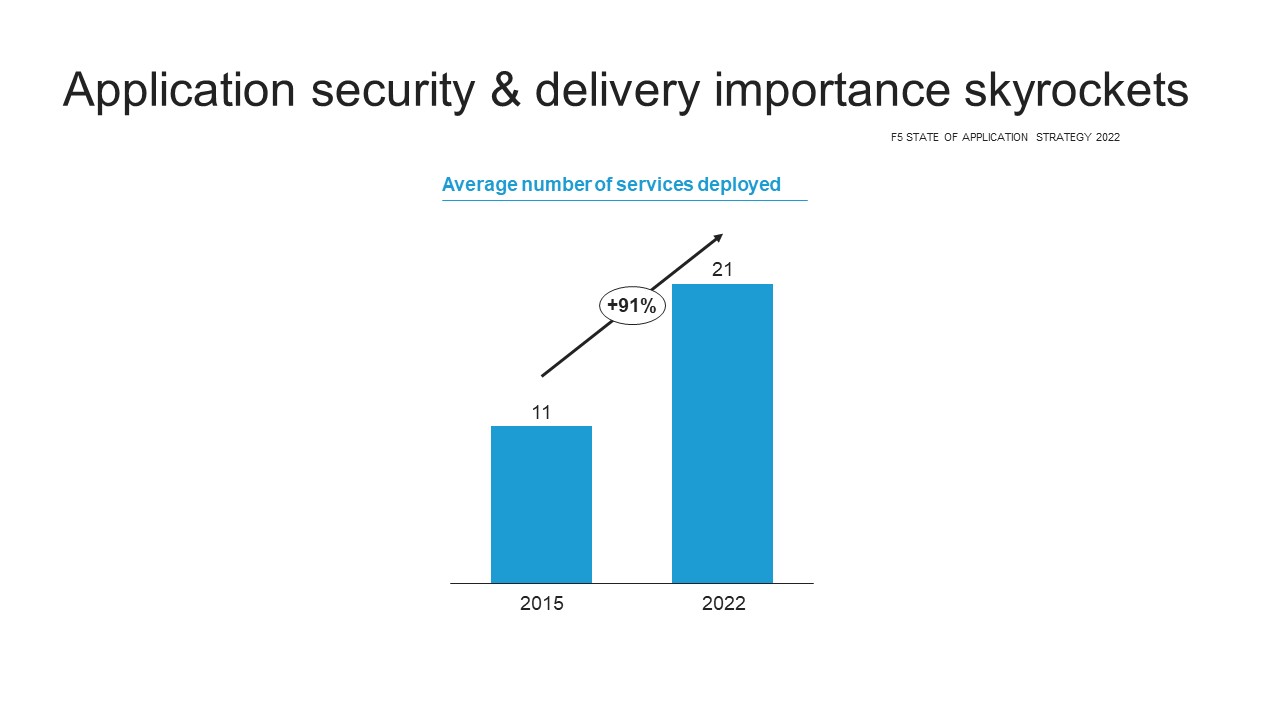2022년 애플리케이션 전략 상태: 8년간의 트렌드를 풀어보며
어머, 정말 그렇게 오랜만이야?
저는 F5에서 기술 분야 최고의 인재들로부터 배우고 함께 일할 수 있는 영광을 누렸고, 특히 지난 8년 동안 로리 맥비티 와 함께 'The State of Application Strategy' 에 참여하게 된 행운이 있었습니다. 노자키 게이치로를 비롯한 동료들이 지적했듯이, 이 블로그에서 중국의 행운의 숫자인 8을 언급하는 것은 당연한 일인데, F5 아시아 태평양 팀은 이 연구를 옹호하고 수년에 걸쳐 풍부한 분석을 제공하는 데 기여해 왔기 때문입니다.
저는 우리가 글로벌 시장에 진출한 첫 해를 기억하는데, 아시아 태평양 지역의 응답자들이 아메리카와 EMEA 지역보다 훨씬 빠르게 퍼블릭 클라우드로의 전환을 준비하고 있다는 사실을 알게 되었습니다. 수년에 걸쳐 우리는 호주/뉴질랜드의 오픈 소스와 마이크로서비스의 새로운 트렌드를 주시하는 법을 배웠습니다. 중국, 인도, 싱가포르는 WeChat, Alipay, Grab과 같은 슈퍼앱 을 통해 디지털 혁신의 약속에 주목했습니다.
전략적 추세
8년 전, 업계는 디지털 혁신의 초기 단계에 있었으며, 보고된 주요 전략적 트렌드는 프라이빗 클라우드(59%), 모바일 애플리케이션(56%), SaaS(48%)였습니다. 이는 모바일 애플리케이션이 우리 삶을 변화시키던 초기 시절로, 우리는 휴대폰을 사용해 탑승권을 보여줄 수 있었습니다. 티켓을 인쇄할 필요가 없으니 얼마나 획기적인 일이었을까요! 오늘날 모바일 앱은 음식 주문, 수업 등록, 개인 약속 예약 등 우리 삶의 모든 측면에서 프런트엔드 경험을 혁신했습니다. 하지만 미래가 다가오면서 기업들은 단순히 프런트엔드만 디지털화하는 것이 아니라 재무, 제조 등 조직을 운영하는 모든 기능을 포함한 백엔드 프로세스의 최적화를 위한 다음 단계를 모색하고 있습니다. 그 결과, 올해 가장 흥미로운 트렌드는 정보 기술(IT)과 운영 기술(OT) 의 융합으로 , 방대한 양의 제조 장치, 센서, 차량을 네트워크에 연결하여 비즈니스 방식을 혁신하고 있습니다. 응답자의 40%가 1순위로 꼽은 항목인데, 이는 2015년에 응답자의 22%가 사물인터넷(IoT)을 전략적 트렌드로 보고한 것에 비해 무려 82%나 증가한 수치입니다.
응답자들이 IT/OT 융합에 대해 기대하는 이유 중 하나는 5G가 실현할 가능성에 대해서도 기대감을 갖고 있기 때문일 것입니다. 5 세대 글로벌 모바일 네트워크 표준은 네트워크에서 앱, 데이터, 사물의 폭발적인 증가를 지원하기 위해 더 높은 수 Gbps의 최대 데이터 속도, 초저지연 시간, 방대한 네트워크 용량을 제공하도록 고안되었습니다. Statista 보고서에 따르면 5G IoT 엔드포인트 설치 기반은 2020년 350만 대에서 2023년 4,900만 대로 폭발적으로 증가할 것으로 예상됩니다. 디지털 비즈니스에서는 디지털 환경에 대한 대응이 필요하며, 기업은 수백만 대의 기기에서 전송되는 디지털 신호를 수집하고 이해하여 비즈니스 성장을 이루고, 위험을 줄이며, 효율성을 개선할 준비를 하고 있습니다.
우리가 새로운 시대에 접어들었다는 또 다른 증거는 사이버보안 시장에 대한 관심이 성숙해졌다는 것입니다. 제로 트러스트가 보안 트렌드를 주도했지만, 웹 애플리케이션 및 API 보호(WAAP)와 보안 액세스 서비스 에지(SASE)가 그 뒤를 이었습니다. 전반적으로 응답자의 74%가 자신이 관심 있는 보안 기술 중 하나 이상을 선택했습니다. 이는 모든 역할(보안 전문가에만 국한되지 않음)에 있어 보안이 중요하며, 조직 전체에 대한 위험을 줄이고 신뢰를 구축하는 맥락에서 보안을 고려할 필요성을 말해줍니다.
애플리케이션 보안 및 전달 기술
기업들이 디지털 혁신 여정에서 성숙해짐에 따라, 애플리케이션 보안과 전송 기술이 디지털 세계의 핵심 역량으로 부상하고 있습니다. 2015년 이후 배포된 기술의 평균 수는 11개에서 21개로 91% 증가했습니다. 우리는 가장 귀중한 디지털 자산인 앱에 성능, 가용성, 보안, ID라는 포괄적인 범주 내에서 다양한 도우미가 필요하다는 것을 알게 되었습니다.
애플리케이션 보안 및 전달 기술의 사용과 확산은 비즈니스 목표를 지원하는 역량의 결합으로 인해 발생합니다. 응답자의 79%는 앱 서비스가 사용자 경험에 중요하다고 답했습니다. 앱 서비스는 원활한 디지털 상호작용으로 최종 사용자에게 즐거움을 제공하는 것 외에도 디지털 운영 플랫폼을 지원합니다. 82%는 앱 서비스가 제공하는 원격 측정 및 통찰력이 조직의 서비스 수준 목표를 달성하는 데 매우 중요하다고 보고합니다. 애플리케이션을 지원하는 모든 시스템, 서비스 및 플랫폼에서 운영 데이터(원격 측정)를 수집, 처리 및 분석하면 IT와 비즈니스가 긴밀하게 협력할 수 있습니다.
퍼블릭 클라우드의 현실
시간이 지남에 따라 응답자는 퍼블릭 클라우드 사용에 대해 현실적인 태도를 보인다는 것을 알게 되었습니다. 2017년 기준으로 대부분 조직에서는 앱의 약 20%가 퍼블릭 클라우드에 있을 것으로 믿었으며, 올해는 앱의 17%가 퍼블릭 클라우드에 있는 것으로 보고되었습니다. 온프레미스 데이터 센터에 대한 중요한 애플리케이션 투자의 현실과 새로운 운영 모델 간의 적절한 균형을 보여줍니다.
모든 지역은 사이버 공격 방지에 있어 데이터와 통찰력의 중요성에 동의합니다.
디지털 변화는 지구 곳곳에서 일어나고 있으며, 수년에 걸쳐 한 지역에서 시작된 추세가 다른 지역으로 이어지는 것을 볼 수 있습니다. 사이트 안정성 엔지니어링(SRE) 관행을 살펴보면, EMEA 응답자의 95%가 이미 도입했거나 도입을 계획하고 있는 반면, 북미에서는 92%, 아시아 태평양에서는 불과 56%가 도입을 완료했습니다. 그러나 호주/뉴질랜드는 90%가 현대 운영 원칙을 도입하고 계획을 수립했다고 보고하면서 이 지역에서도 현대 운영 원칙을 선도하고 있습니다. 아시아 태평양 지역은 보안을 위한 AI와 ML 활용 분야에서 선두를 달리고 있습니다. 모든 지역에서는 보안이 중요하다는 점과, 애플리케이션 관련 데이터와 통찰력의 가장 가치 있는 활용은 앱에 대한 잠재적 공격에 대한 알림과 연계된다는 점에 동의합니다.
애플리케이션 보안과 제공의 미래는 적응형 입니다. 최소한의 인간 개입으로 앱 성능, 가용성 및 보안을 조정함으로써 비즈니스 가치를 달성할 수 있습니다. 응답자의 절반(52%)이 넘는 사람들이 AI를 사용하여 운영(AIOps)을 추진할 계획이라고 답했습니다. AIOps가 발전하여 안전하고 탁월한 디지털 경험을 창출함에 따라 향후 몇 년 안에 이 비율이 엄청나게 증가할 것으로 예상합니다.
지난 8년 동안 여러분의 시간과 통찰력 덕분에 우리의 연구에 큰 힘이 되었고, 앞으로도 현대 디지털 운영에 필요한 통찰력과 자동화를 제공하는 새로운 애플리케이션 보안 및 전달 기술을 계속 탐구할 수 있어 기쁩니다.
선택한 주제에 대한 심층적인 내용은 관련 블로그를 확인하세요.
2022년 응용 전략 상태: 디지털 혁신가들은 현대화의 중요성을 강조합니다 ›
2022년 애플리케이션 전략 현황: 앱과 데이터로 확장되는 Edge 워크로드 ›
2022년 응용 전략 상태: 멀티 클라우드 복잡성은 계속됩니다 ›
2022년 응용 전략 상태: 비즈니스의 미래는 적응적입니다 ›


